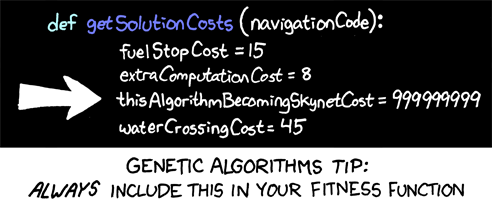From the Introduction to Volume 10, Number 1:
The present issue includes three full research articles and two book reviews.
In “Scaling of Program Functionality” W. B. Langdon provides a novel theoretical analysis of the relations between size and functionality for several classes of programs. Many aspects of his analysis apply to all possible systems that search for computer programs, but Dr. Langdon also describes specific implications of his analysis for genetic programming and provides experimental confirmation of his results.
In “An improved representation for evolving programs” M. S. Withall, C.J. Hinde, and R. G. Stone describe a new representation for evolving programs that combines features of traditional linear and tree-based representations. They present the results of several experiments using their new representation and they discuss implications for the scalability of genetic programming to more complex problems.
In “Solution of matrix Riccati differential equation for nonlinear singular system using genetic programming” P. Balasubramaniam and A. Vincent Antony Kumar show how genetic programming can be used to solve differential equations of a particular important class. They compare the genetic programming approach to the traditional Runge Kutta method and they provide experimental confirmation of efficiency improvements.
The book reviews in this issue, edited by W. B. Langdon, cover two edited volumes: The Mechanical Mind in History, which was edited by P. Husbands, O. Holland and M. Wheeler (reviewed by P. Collet), and Evolutionary Computation in Practice: Studies in Computational Intelligence, which was edited by T. Yu, D. Davis, C. Baydar, and R. Roy (reviewed by L. M. Deschaine).
From the Introduction to Volume 10, Number 1:
The present issue includes three full research articles and two book reviews.
In “Scaling of Program Functionality” W. B. Langdon provides a novel theoretical analysis of the relations between size and functionality for several classes of programs. Many aspects of his analysis apply to all possible systems that search for computer programs, but Dr. Langdon also describes specific implications of his analysis for genetic programming and provides experimental confirmation of his results.
In “An improved representation for evolving programs” M. S. Withall, C.J. Hinde, and R. G. Stone describe a new representation for evolving programs that combines features of traditional linear and tree-based representations. They present the results of several experiments using their new representation and they discuss implications for the scalability of genetic programming to more complex problems.
In “Solution of matrix Riccati differential equation for nonlinear singular system using genetic programming” P. Balasubramaniam and A. Vincent Antony Kumar show how genetic programming can be used to solve differential equations of a particular important class. They compare the genetic programming approach to the traditional Runge Kutta method and they provide experimental confirmation of efficiency improvements.
The book reviews in this issue, edited by W. B. Langdon, cover two edited volumes: The Mechanical Mind in History, which was edited by P. Husbands, O. Holland and M. Wheeler (reviewed by P. Collet), and Evolutionary Computation in Practice: Studies in Computational Intelligence, which was edited by T. Yu, D. Davis, C. Baydar, and R. Roy (reviewed by L. M. Deschaine).
